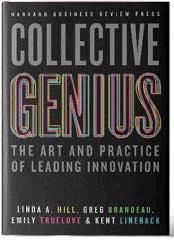How Innovative Organizations Think: Why Rules Matter
By Linda Hill, professor, Harvard Business School
 Innovation and rules may seem like an odd couple. Aren’t innovators rule breakers, people who are willing — even eager — to challenge the status quo? For the most part, they are. Yet innovations rarely result from a genius having a single flash of insight. Instead, they emerge from a collaborative process of individuals with diverse perspectives generating a portfolio of ideas, testing and refining them, and finally, choosing a solution — most often one that combines seemingly competing ideas. Heated debate and conflict are a necessary part of cocreating the new — and as any leader knows, it can become hard for the group to bear. So how do innovative teams ensure this competition of ideas remains constructive, instead of devolving into chaos? They tend to follow three “rules” of innovative thinking: They question everything, they are driven by data, and they aim to see the whole.
Innovation and rules may seem like an odd couple. Aren’t innovators rule breakers, people who are willing — even eager — to challenge the status quo? For the most part, they are. Yet innovations rarely result from a genius having a single flash of insight. Instead, they emerge from a collaborative process of individuals with diverse perspectives generating a portfolio of ideas, testing and refining them, and finally, choosing a solution — most often one that combines seemingly competing ideas. Heated debate and conflict are a necessary part of cocreating the new — and as any leader knows, it can become hard for the group to bear. So how do innovative teams ensure this competition of ideas remains constructive, instead of devolving into chaos? They tend to follow three “rules” of innovative thinking: They question everything, they are driven by data, and they aim to see the whole.
WHY DO GROUPS NEED “RULES” FOR THINKING?
In Collective Genius: The Art and Practice of Leading Innovation, we distilled more than a decade of research about what leaders do to build innovative organizations. Their priority: creating the culture and capabilities required to support the hard work of innovation — including embedding norms or “rules of engagement” that govern how the group thinks about and solves problems.
QUESTION EVERYTHING
Innovative groups consciously question everything — especially the status quo. Instead of declaring certain practices, policies, ideas, or assumptions off-limits, they embrace lively inquiry and even friendly skepticism. The leaders we studied told us that this practice not only animates discovery, but helps them attract top talent — people who approach problems like intrepid explorers enjoy working with others who challenge conventional wisdom.
BE DATA-DRIVEN
Innovative groups consistently pay attention to data. They voraciously collect and analyze information of all kinds: cost figures, test results, customer feedback, retention statistics … you name it, they want it. Since innovative solutions often result from a process of trial and error, these groups crave quantitative or qualitative metrics to give them feedback on what is (and isn’t) working.
If this sounds obvious, think about how often groups make decisions in spite of hard evidence simply because they believe the evidence doesn’t apply to them, see the data as flawed, or don’t want to face what the data is telling them. This refusal to face facts limits discovery.
SEE THE WHOLE
 Innovative groups maintain a holistic view of problems. It is easy — and only human — for individuals to focus on one part of a problem, rather than seeing how the parts fit together. But the best solutions often combine disparate elements, which can be appreciated only by understanding the whole picture, including connections, interdependencies, and patterns. These practices allow teams to see problems within a broader context or from multiple perspectives.
Innovative groups maintain a holistic view of problems. It is easy — and only human — for individuals to focus on one part of a problem, rather than seeing how the parts fit together. But the best solutions often combine disparate elements, which can be appreciated only by understanding the whole picture, including connections, interdependencies, and patterns. These practices allow teams to see problems within a broader context or from multiple perspectives.
Our current research suggests that embedding these norms is one of the hardest but most important things for leaders to do. Taken together, these rules keep team members focused on what is most important, discourage unproductive behaviors, and encourage activities that foster collaboration, discovery-driven learning, and integrative decision making.
